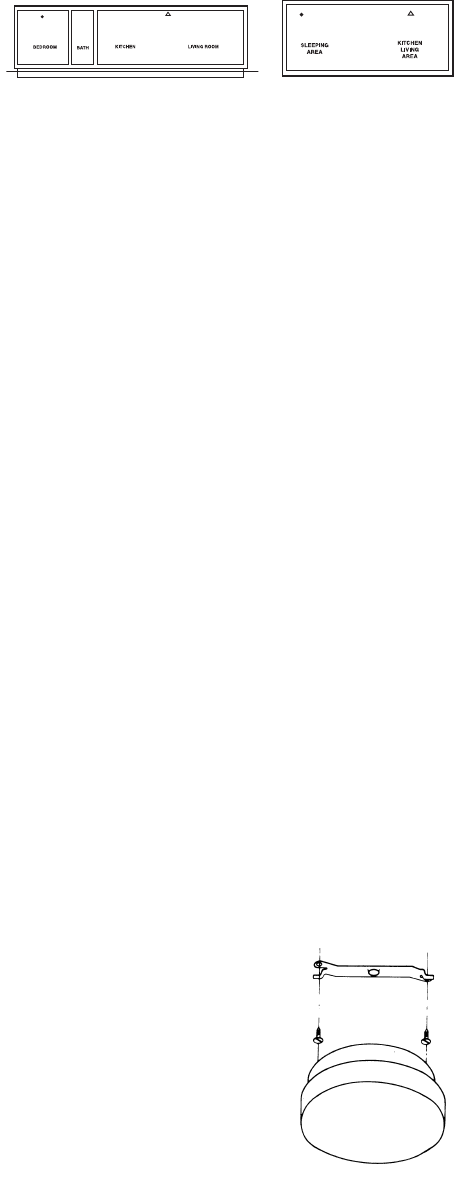
4
WHERE YOU SHOULD NOT INSTALL SMOKE ALARMS
• Do not install a smoke alarm within close proximity of heating and
cooling supply vents or within close proximity of return or fresh air
vents. Smoke may be blown away from the smoke alarm by the
supply vents, or could be diffused or reduced by being diverted into
the return air vent. The NFPA states in Standard 72E, Section 4-4.1:
“In rooms, buildings, where forced ventilation is present, detectors
shall not be located where air from supply diffusers (“vents”) could
dilute smoke before it reaches the detector.”
• Do not install your smoke alarm in an area where the temperature
may fall below 40°F, or rise above 100°F. Smoke alarms are designed
to work safely only within these temperature ranges, and failure to
alarm, improper alarms or nuisance alarms may result from operation
outside these temperature limits.
• Do not install a smoke alarm in damp or very humid areas such as
bathrooms with showers, where the normal humidity may rise above
93% relative humidity. Above this level, moisture may condense
inside the smoke chamber and cause false alarms.
• Do not install a smoke alarm in an area where particles of combustion
are normally present, such as kitchens or automobile garages, unless
the smoke alarm has a False Alarm Control feature.
• Do not install a smoke alarm in dusty or dirty areas; SUCH AN INSTAL-
LATION CANNOT BE RELIED UPON. An accumulation of dust and dirt
in the sensing chamber may block the openings and prevent an
alarm, or may get inside the alarm and cause false alarms. If a smoke
alarm is required in such an area, vacuum it frequently and test it
according to the section “TAKING CARE OF YOUR SMOKE ALARM.”
• Do not install a smoke alarm in the dead air space in the corner
where the wall meets the ceiling. If in doubt as to the exact location
of mounting, for your safety, contact your local fire department for
help in choosing a location.
• Do not install a smoke alarm where bugs or insects are present
before eliminating or minimizing the bug problem. Although all smoke
alarms built since 1986 are made to help prevent bugs from entering
the detection chamber, bugs may build up on chamber openings and
prevent smoke from entering. As a result, unit should be vacuumed
frequently as explained in the section “TAKING CARE OF YOUR
SMOKE ALARM.”
• Do not install a smoke alarm within close proximity of a fluorescent
light. Electrical noise may cause nuisance alarms.
HOW TO INSTALL YOUR SMOKE ALARM
AFTER HAVING CAREFULLY READ THE FIRST FIVE SECTIONS OF THIS MANUAL,
YOU ARE READY TO INSTALL YOUR SMOKE ALARM.
PLEASE FOLLOW THESE DIRECTIONS:
1. Unlock and remove mounting
bracket from smoke alarm with
a counterclockwise twist.
2. Place mounting bracket on ceiling or
wall in prearranged location and use
pencil to trace two opposing hole
positions for mounting screws. Drill
two 1/16-inch holes.
3. Use mounting screws provided for
attaching to studs or woodwork. For
plaster or plasterboard, you may wish
to use plastic anchors and screws. See
Figure 6.
4. Screw mounting bracket to surface securely. NOTE: Before mounting
alarm on a wall, be sure arrow on mounting bracket is pointing up
toward ceiling. See Figure 6.
5. Install battery. (See “REPLACING THE BATTERY”)
6. Attach smoke alarm to mounting bracket with a clockwise twist until
it snaps into locked position. NOTE: Your smoke alarm is designed
with a safety mechanism that prevents mounting unless a battery is
installed. This helps ensure the alarm is functional when mounted.
7. You have now finished installing your smoke alarm. For your safety,
proceed with testing described in the next section.
WEEKLY TESTING OF YOUR SMOKE ALARM
1. FOR A COMPLETE WEEKLY TEST OF THE ELECTRONICS AND THE
SENSOR OPERATION, FIRMLY DEPRESS THE TEST BUTTON ON THE
COVER OF THE SMOKE ALARM FOR A FEW SECONDS. The smoke
alarm will sound by making a continuous loud beeping noise. On
models with an LED (light emitting diode) the indicator light under the
clear Push-to-Test button will blink once per second while the button
is being pushed and the alarm is sounding. The smoke alarm will stop
sounding when you release the button.
MOBILE HOME
EFFICIENCY APARTMENT
FIGURE 5: EFFICIENCY APARTMENT AND MOBILE HOME INSTALLATION
FIGURE 6
110-631F English 12/12/06 3:37 PM Page 4










